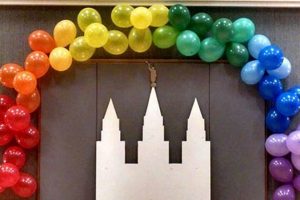Creating festive holiday ornamentation above eye level offers an opportunity to enhance the immersive nature of seasonal dcor. Such projects typically involve crafting and installing various decorative elements on the upper surface of a room to contribute to a celebratory atmosphere. Examples include hanging ornaments, constructing mobile-like arrangements, or suspending garlands and lights across the room’s expanse.
Ornamentation of this overhead space provides multiple advantages. It maximizes the use of available space for decorations, especially in smaller rooms. Overhead displays create a greater sense of depth and visual interest, enriching the overall aesthetic impact. Historically, decorating the highest points of a room has been associated with bringing good fortune and celebrating the spirit of the season in many cultures.
The subsequent sections will detail specific approaches to fabricating and installing overhead seasonal embellishments, highlighting aspects of design, material selection, safety considerations, and securing elements to the upper room surface.
DIY Christmas Ceiling Decorations Tips
Effective execution of festive overhead ornamentation requires careful planning and adherence to safety protocols. The following guidelines offer practical advice for successful installation and prolonged enjoyment of these festive displays.
Tip 1: Material Selection: Prioritize lightweight materials to minimize the risk of detachment and potential damage to the ceiling. Consider using plastic ornaments, lightweight fabrics, or paper-based decorations. Avoid heavy glass ornaments or metallic structures that could pose a hazard.
Tip 2: Secure Attachment Methods: Utilize appropriate attachment methods based on ceiling material. For drywall ceilings, use screw-in hooks or anchors rated for the anticipated weight. For plaster ceilings, consider using adhesive hooks specifically designed for plaster to minimize surface damage. For suspended ceilings, utilize clips designed to attach to the grid system.
Tip 3: Weight Distribution: Distribute weight evenly across the ceiling to prevent localized stress. Avoid concentrating heavy items in a single area. When hanging garlands or lights, ensure they are supported at multiple points along their length.
Tip 4: Lighting Considerations: When incorporating lights, use LED lights to minimize heat generation and reduce the risk of fire. Ensure that all electrical connections are secure and follow manufacturer’s instructions. Never overload electrical circuits.
Tip 5: Height Clearance: Maintain adequate height clearance to prevent accidental contact with decorations. Consider the typical height of occupants and the presence of ceiling fans or other fixtures that could interfere with the display.
Tip 6: Design Harmony: Coordinate the overhead display with existing room dcor to create a cohesive aesthetic. Consider the color scheme, style, and scale of the decorations to ensure they complement the overall environment.
Tip 7: Regular Inspection: Periodically inspect the decorations for any signs of loosening, damage, or wear. Address any issues promptly to prevent potential hazards.
Implementing these techniques ensures that overhead holiday embellishments are not only visually appealing but also securely installed and maintained. Prioritizing safety and careful planning leads to a positive and enduring festive display.
The subsequent section will address design inspiration and creative concepts for overhead festive displays, building upon the aforementioned foundational principles.
1. Planning & Design
The creation of overhead festive arrangements necessitates thorough planning and design as foundational elements. A pre-determined design provides a blueprint, guiding material selection, spatial arrangement, and overall aesthetic. Without careful planning, overhead decorations can appear haphazard, creating visual clutter and potentially compromising structural safety. For example, a design may incorporate a central hanging ornament surrounded by radiating strands of fairy lights, requiring precise measurements to ensure symmetry and balanced weight distribution. Conversely, a lack of planning may result in uneven light distribution or excessive strain on a single attachment point, increasing the risk of failure.
Further, effective design considers the existing architecture and interior dcor. An overhead arrangement should complement the room’s style and color palette, creating a unified festive atmosphere. For instance, a minimalist room might benefit from a simple garland of greenery and subtle lighting, while a more traditional space could accommodate a more elaborate display of ornaments and ribbons. Successful integration requires assessing the room’s dimensions, ceiling height, and the placement of existing fixtures to ensure the overhead display enhances rather than detracts from the overall aesthetic.
In conclusion, comprehensive planning and deliberate design are essential precursors to the successful realization of overhead seasonal adornments. These preliminary stages dictate the aesthetic impact, structural integrity, and overall feasibility of the project. Careful planning mitigates potential risks, ensures aesthetic coherence, and ultimately contributes to a more enjoyable and visually compelling festive environment.
2. Material Selection
Material selection critically influences the success and safety of overhead seasonal adornments. The materials chosen directly impact the weight load placed on the ceiling, the aesthetic appeal of the display, and its long-term durability. For example, opting for lightweight plastic ornaments instead of heavier glass alternatives reduces the risk of detachment and potential ceiling damage. Similarly, using fire-resistant fabrics for garlands or draperies minimizes the risk of fire hazards associated with electrical lighting. The selection of inappropriate materials presents a tangible threat to the structural integrity of the display and the safety of occupants.
The aesthetic impact is equally dependent on material choices. Natural materials, such as pine branches or dried flowers, evoke a rustic, traditional ambiance, while metallic or iridescent materials lend a modern, sophisticated feel. The scale and texture of materials also contribute to the overall visual effect. Large, bulky ornaments may overwhelm a small room, while delicate, intricate details may be lost in a larger space. A deliberate approach to material selection, considering texture, color, scale, and material properties, is necessary to achieve the desired aesthetic outcome. For instance, using reflective materials like tinsel or mirrored ornaments can amplify the effect of lighting, creating a more dynamic and visually captivating display.
In summary, the process of selecting materials for overhead holiday decorations is directly correlated to the outcome of the project. The implications of poor material choices span safety, aesthetics, and structural integrity. Therefore, a comprehensive understanding of material properties, weight limitations, and safety standards is crucial for creating visually compelling and structurally sound overhead seasonal adornments. Failure to prioritize material selection compromises both the longevity of the display and the safety of the environment.
3. Attachment Methods
The security and stability of overhead festive installations depend significantly on the chosen attachment methods. These methods directly influence the safety and longevity of the display, dictating the appropriate load-bearing capacity and compatibility with ceiling materials.
- Hook and Anchor Selection
The choice of hooks and anchors is critical. Screw-in hooks provide secure fastening in drywall or wood, while adhesive hooks offer a damage-free alternative for smooth surfaces, though with reduced weight capacity. Toggle bolts and molly bolts are required when hanging heavier items, as they expand behind the ceiling surface to provide increased support. The selected hook and anchor must be rated to support the weight of the decoration, with a safety margin to account for unexpected stress. Improper selection leads to potential detachment and damage.
- Ceiling Material Compatibility
Attachment methods must align with the ceiling’s composition. Drywall requires different anchors than plaster or suspended ceilings. Drilling into plaster can cause cracking if not done carefully, necessitating specialized plaster anchors. Suspended ceilings demand clips designed for the grid system, avoiding direct weight on the tiles. Ignoring ceiling material can result in installation failure and ceiling damage.
- Weight Distribution Techniques
Distributing weight across multiple attachment points prevents localized stress. For garlands or string lights, use multiple hooks spaced evenly along their length. Avoid concentrating the entire weight of a large ornament on a single hook. Distributing the load enhances the stability and minimizes the risk of detachment. Unbalanced weight distribution jeopardizes the stability and could cause part of or all of the installation to fall.
- Safety Considerations
Prioritize safety by utilizing locking mechanisms on hooks to prevent accidental slippage. Regularly inspect attachment points for signs of loosening or wear. Ensure that all attachment hardware is new and undamaged. Compromised attachment points pose a safety risk and require immediate attention. Failing to address signs of wear may result in catastrophic failure of the installation, leading to potential injury.
The careful selection and application of appropriate attachment methods are imperative for the successful creation and maintenance of overhead festive installations. Adherence to best practices ensures both the visual appeal and the structural integrity of the seasonal dcor.
4. Weight Distribution
Weight distribution is a critical factor in the implementation of overhead seasonal embellishments. The mass and placement of decorations directly influence the structural integrity of the supporting ceiling. Improper weight distribution introduces a significant risk of damage, ranging from minor cracks to complete ceiling collapse. For example, suspending a heavy cluster of ornaments from a single attachment point can exert excessive force, potentially causing drywall to crumble or plaster to detach. Conversely, distributing the weight of a garland along multiple attachment points minimizes stress and prevents localized strain. Therefore, careful consideration of weight distribution is not merely an aesthetic consideration, but a fundamental safety requirement.
The practical application of weight distribution principles involves assessing the load-bearing capacity of the ceiling and selecting appropriate attachment methods. Drywall ceilings, typically less robust than plaster or concrete, require specialized anchors designed to spread the weight over a larger surface area. Using multiple lighter decorations instead of a single heavy one achieves the same visual effect with reduced risk. Further, the type of decoration influences weight distribution. Linear decorations, such as garlands or strings of lights, should be supported at regular intervals to prevent sagging and uneven stress. Complex arrangements, like mobiles or elaborate ornament clusters, necessitate careful balancing to ensure even distribution of weight across all suspension points. This balanced approach minimizes the risk of any single point bearing an undue load.
In conclusion, effective weight distribution is an essential component of safe and successful overhead seasonal embellishments. Failure to adequately address this factor can result in structural damage and potential safety hazards. Applying sound engineering principles, utilizing appropriate attachment hardware, and carefully balancing the load are imperative for ensuring the long-term stability and visual appeal of the display. Addressing these challenges proactively minimizes risks and fosters a more enjoyable and secure festive environment.
5. Lighting Integration
The incorporation of lighting is an integral element in the successful execution of overhead festive ornamentation. Illumination not only enhances the visual impact of the decor but also contributes significantly to the overall ambiance and mood of the space.
- Ambiance and Mood Creation
Lighting strategically deployed amplifies the intended atmosphere. Warm-toned lights evoke a cozy, inviting feeling, while cooler tones offer a more modern or ethereal aesthetic. Dimmable lights provide flexibility in adjusting the intensity to suit different occasions or preferences. For instance, soft, diffused lighting contributes to a relaxed holiday gathering, while brighter, more vibrant illumination is appropriate for a festive celebration. The intentional selection of light color and intensity is therefore crucial in setting the desired tone.
- Highlighting Decorative Elements
Strategic placement of lights can accentuate specific decorative elements, drawing attention to key features of the display. Spotlights or strategically placed string lights can emphasize intricate ornaments or highlight the texture of garlands. Backlighting can create a dramatic silhouette effect, adding depth and dimension to the arrangement. An example would be placing small spotlights to shine upward onto hanging icicle ornaments, creating a shimmering effect. Thoughtful lighting enhances the visual impact and creates focal points within the overhead decor.
- Safety Considerations
Safe lighting practices are paramount when integrating lights into overhead decorations. LED lights are recommended due to their low heat output, reducing the risk of fire hazards. Ensure all electrical connections are secure and follow manufacturer’s instructions. Never overload electrical circuits. Inspect lights regularly for damage and replace any faulty components immediately. Using battery-operated lights eliminates the need for extension cords, reducing tripping hazards. Prioritizing safety minimizes the risk of accidents and ensures a safe and enjoyable festive environment.
- Power Source and Concealment
Careful planning regarding power source location and wire concealment contributes to the aesthetic appeal and safety of the display. Ideally, outlets should be readily accessible to avoid the need for long extension cords. Concealing wires minimizes visual clutter and reduces tripping hazards. Utilizing clips or cable ties to secure wires along the ceiling or walls ensures a neat and organized appearance. Battery-operated lights offer greater flexibility in placement, eliminating the need for proximity to electrical outlets. A well-planned power management system enhances the overall aesthetic and safety of the overhead decoration.
The convergence of thoughtful lighting design and diligent safety protocols is pivotal in achieving a compelling and secure overhead holiday display. From accentuating specific ornaments to influencing the overall ambiance, lighting stands as a cornerstone in realizing a truly captivating festive environment.
6. Safety Precautions
The implementation of safety precautions is paramount when undertaking overhead festive embellishments. The elevated nature of these installations introduces inherent risks, necessitating a comprehensive approach to prevent potential hazards. These risks span structural failures, electrical mishaps, and physical injuries. Therefore, adherence to stringent safety protocols is indispensable for ensuring a secure and enjoyable festive environment.
- Load Capacity Assessment
Determining the weight-bearing limits of the ceiling structure is a fundamental safety precaution. Exceeding these limits poses a significant risk of ceiling damage or collapse. Consult construction documentation or qualified professionals to ascertain the ceiling’s capacity. This information guides material selection and attachment methods, preventing overloading and structural failure. For instance, a drywall ceiling typically possesses a lower load capacity compared to a concrete ceiling, necessitating lighter decorations and more robust anchoring systems.
- Electrical Safety Protocols
The integration of electrical lighting demands strict adherence to safety guidelines. Utilize LED lights, which generate minimal heat, reducing the risk of fire hazards. Inspect all wiring and connections for damage prior to installation. Employ surge protectors to safeguard against electrical overloads. Never overload circuits by connecting too many lights to a single outlet. Regularly examine the lighting for wear and tear, and promptly replace any faulty components. Disregarding these electrical safety protocols can result in electrocution or fire.
- Secure Attachment Techniques
Employing secure attachment techniques prevents decorations from detaching and falling, mitigating the risk of injury. Select appropriate anchors based on the ceiling material and the weight of the decoration. Ensure that all hooks and fasteners are rated for the intended load. Distribute weight evenly across multiple attachment points to prevent localized stress. Regularly inspect the attachment hardware for signs of loosening or damage. For example, use screw-in hooks in drywall ceilings with a rated weight capacity higher than the ornaments being hung. Neglecting these attachment measures can lead to falling objects and potential injuries.
- Obstruction and Clearance Considerations
Maintaining adequate clearance around decorations prevents accidental contact and potential injuries. Ensure sufficient headroom beneath hanging decorations to avoid head injuries. Position decorations away from doorways, walkways, and areas with high foot traffic. Consider the location of ceiling fans and other fixtures to prevent interference with the display. For instance, hanging a large ornament directly in the path of a ceiling fan could cause the ornament to detach and fall. Addressing these obstruction and clearance considerations minimizes the risk of accidents.
The multifaceted nature of safety precautions underscores their indispensable role in the creation of overhead festive installations. These measures span structural assessment, electrical safety, attachment security, and clearance considerations. The diligent implementation of these protocols serves as a foundational element for ensuring a secure and enjoyable festive ambiance.
7. Aesthetic Harmony
The concept of aesthetic harmony holds significant relevance in the context of seasonal overhead embellishments. A cohesive and visually pleasing environment is achieved through the deliberate integration of overhead decorations with existing room decor. A lack of aesthetic harmony results in a visually jarring and disjointed atmosphere, detracting from the intended festive ambiance.
- Color Palette Integration
A harmonious color palette is essential for creating a unified aesthetic. Overhead decorations should complement the existing color scheme of the room. For instance, if the room features neutral tones, ornaments and garlands in metallic or jewel tones can provide a subtle contrast. Conversely, a room with bold colors may benefit from decorations in complementary hues. A mismatch in color palettes creates visual dissonance and disrupts the overall aesthetic appeal. Failure to incorporate a pre-determined color palette is a common mistake made during the design process.
- Style Consistency
Maintaining a consistent style throughout the room, including the overhead decorations, contributes to a cohesive aesthetic. If the room’s style is modern and minimalist, ornaments and garlands with clean lines and simple designs are appropriate. A traditional room might accommodate more elaborate and ornate decorations. Contrasting styles create visual conflict and detract from the intended aesthetic. A carefully constructed design considers that a rooms existing design style must be considered before implementing changes in dcor.
- Scale and Proportion
The scale and proportion of overhead decorations should be appropriate for the size and dimensions of the room. Overly large decorations overwhelm a small room, while small decorations may be lost in a larger space. The ceiling height also influences the appropriate scale of the decorations. Higher ceilings can accommodate larger ornaments and more elaborate arrangements. Overwhelming dcor may create a feeling of claustrophobia and spatial imbalance. Before purchasing large decorations, take exact measurements and plan a space that provides sufficient scale.
- Material Coherence
The materials used in overhead decorations should be consistent with the overall material palette of the room. Using natural materials, such as wood and greenery, creates a rustic and organic feel. Metallic or synthetic materials contribute to a more modern aesthetic. Inconsistent material choices create visual discord and disrupt the sense of harmony. A room that employs metallic and glass decorations must consider the effect of other materials so as not to damage the overall design.
In summary, the successful creation of overhead festive adornments relies heavily on the principle of aesthetic harmony. Careful consideration of color palettes, style consistency, scale and proportion, and material coherence results in a visually pleasing and unified festive environment. When considered as a total integration of each design element, aesthetic harmony ensures the end result improves the seasonal decoration.
Frequently Asked Questions
This section addresses common inquiries and concerns related to the creation and implementation of overhead festive adornments.
Question 1: What is the recommended maximum weight for decorations suspended from a drywall ceiling?
The recommended maximum weight varies depending on the type of anchor used and the thickness of the drywall. Generally, it is advisable to use anchors rated for at least 10 pounds, and to distribute weight across multiple attachment points. Consult the anchor manufacturer’s specifications for precise weight limits.
Question 2: What are the safest types of lighting to use in overhead Christmas decorations?
LED lights are the safest option due to their low heat output. They minimize the risk of fire and are energy-efficient. Ensure that all electrical connections are secure and that the lighting is not overloading the circuit.
Question 3: How can damage to the ceiling be avoided when installing overhead decorations?
Utilize appropriate attachment methods based on the ceiling material. Adhesive hooks are suitable for smooth surfaces, while screw-in anchors provide a more secure hold for drywall or plaster. Avoid using nails, which can cause significant damage. Conduct a survey of the ceiling and make sure its integrity is not comprised.
Question 4: How frequently should overhead decorations be inspected for safety?
Overhead decorations should be inspected at least once a week, or more frequently if they are subjected to stress from wind or movement. Check for loose attachments, frayed wires, or any other signs of wear or damage.
Question 5: What is the best way to conceal wires from overhead Christmas lights?
Use cable clips or ties to secure wires along the ceiling or walls. Paintable cord covers can also be used to conceal wires and blend them with the surrounding decor. For an invisible look, use recessed lights or battery-operated lights to remove the need for any cords.
Question 6: How can a balanced and aesthetically pleasing overhead Christmas display be achieved?
Plan the design in advance, considering the color scheme, style, and scale of the decorations. Distribute the weight evenly across the ceiling. Consider the existing room decor and create a cohesive theme. It is often recommended to sketch an outline and consider the visual and physical balance of the entire composition.
In summary, safety, careful planning, and appropriate materials are essential for successful and enjoyable overhead festive embellishments. Always prioritize structural integrity and electrical safety when creating these displays.
The following section will provide concluding remarks and suggestions for further exploration of seasonal dcor.
Conclusion
This exploration of “diy christmas ceiling decorations” has underscored the importance of meticulous planning, material selection, and adherence to safety protocols. Secure attachment methods, proper weight distribution, and the integration of appropriate lighting are critical elements for creating a visually appealing and structurally sound overhead festive display. The principles of aesthetic harmony, encompassing color palette, style consistency, and scale, further contribute to a cohesive and pleasing environment.
The realization of impactful overhead seasonal ornamentation requires a balanced approach, prioritizing both visual impact and structural integrity. Diligent application of the aforementioned principles fosters a safe and aesthetically harmonious environment, enhancing the celebratory ambiance of the season. Continued exploration and innovation within these parameters will further refine the practice of overhead holiday embellishment.







